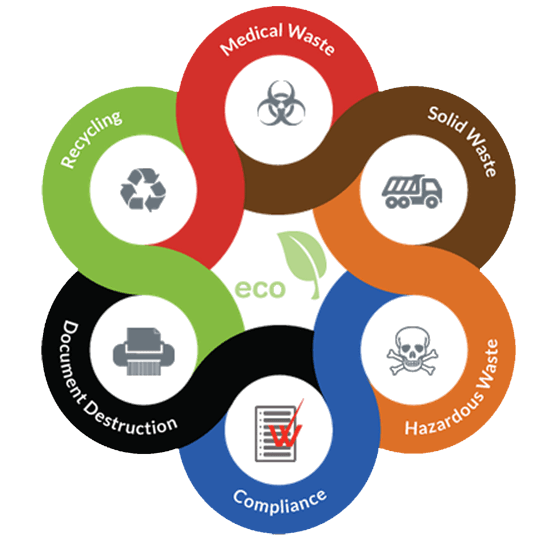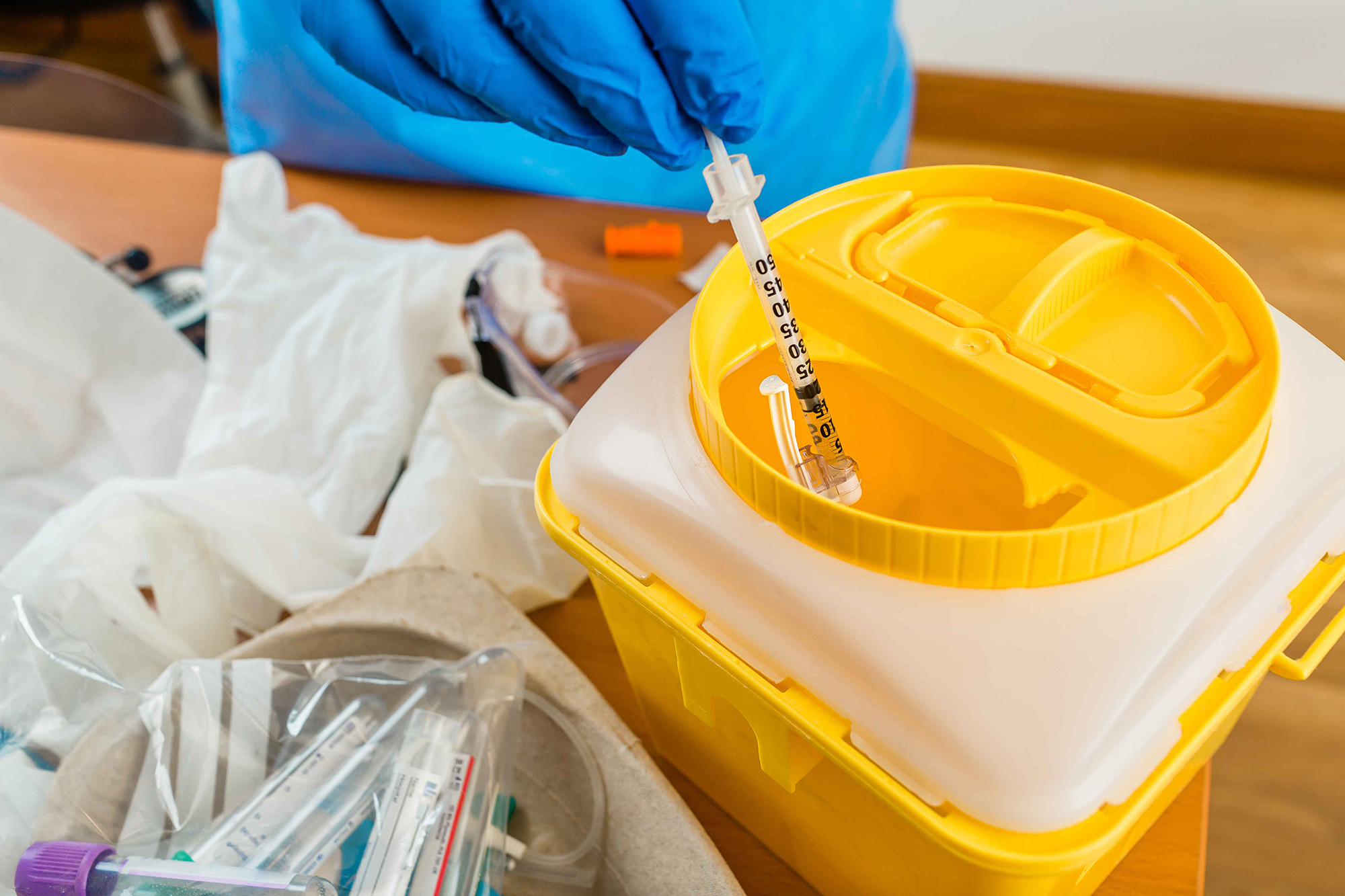Strategic Medical Waste Disposal Solutions: Supporting Safety And Security and Sustainability
Wiki Article
Effective Methods of Medical Waste Disposal
Reliable approaches of medical garbage disposal are crucial in preserving public health and wellness and environmental safety and security. Clinical waste, including sharps, pathological waste, and pharmaceutical waste, should be taken care of and gotten rid of effectively to prevent the spread of infections and safeguard the atmosphere. This calls for adherence to stringent laws and the implementation of specialist waste monitoring practices.Proper segregation of medical waste, safe and safe storage, effective treatment and disinfection methods, and environmentally-friendly disposal alternatives are essential components of an effective medical waste disposal system. Professional waste monitoring services play an important function in guaranteeing compliance with regulations and reducing the risks related to improper disposal. By employing these approaches, medical care centers can add to a safer and cleaner environment while protecting the well-being of the area.
Correct Partition of Medical Waste
Correct partition of clinical waste is crucial for making certain the risk-free and efficient disposal of these possibly dangerous materials. Medical waste describes any waste generated throughout medical care activities, such as healthcare facilities, facilities, research laboratories, and study facilities. It includes a vast array of materials, such as made use of needles, syringes, polluted dressings, expired or extra medicines, and biological products.By segregating clinical waste, healthcare centers can minimize the threat of infections, injuries, and ecological contamination. The process includes classifying waste into various types, such as sharps, infectious waste, pharmaceutical waste, and non-hazardous waste. Each kind needs details handling, packaging, and disposal approaches to stop exposure to healthcare workers, waste monitoring employees, and the public.
To guarantee correct partition, health care centers should establish clear standards and provide appropriate training to personnel. This consists of educating workers on the various waste groups, proper packaging techniques, and making use of proper containers - WasteX Medical Waste Disposal. Additionally, clear signage and color-coding systems can be carried out to assist in the identification and partition of various waste kinds
Safe and Secure Storage Space of Medical Waste
Safe and secure storage of medical waste is essential for maintaining the stability and containment of potentially dangerous materials. Correct storage not just protects healthcare workers and the general public from exposure to dangerous compounds however likewise stops ecological contamination.To guarantee secure storage space, medical centers must adhere to specific guidelines. Waste needs to be kept in puncture-resistant and watertight containers that are identified appropriately - medical waste removal service.
Appropriate segregation of medical waste is additionally crucial for risk-free storage. Various sorts of waste, such as sharps, transmittable products, and pharmaceutical waste, must be separated to stop cross-contamination. This segregation can be attained with making use of color-coded containers or containers.
Regular surveillance and assessment of the storage space area are essential to determine any possible risks or violations. This includes monitoring for indicators of damage or wear and tear in the containers, ensuring appropriate ventilation, and keeping an eye on temperature and moisture degrees.
Effective Therapy and Sanitation Techniques

One generally made use of therapy technique is autoclaving, which involves subjecting the waste to high-pressure vapor at temperature levels above 121 degrees Celsius. One more approach is incineration, which entails burning the waste at high temperatures.
Chemical sanitation is an additional efficient technique for treating clinical waste. This technique involves making use of anti-bacterials such as chlorine compounds, phenolic substances, or hydrogen peroxide to kill or suspend microorganisms (WasteX Medical Waste Disposal). Chemical sanitation is usually utilized for fluid waste, such as lab samples or physical fluids
Recently, alternative therapy methods such as microwave sanitation, irradiation, and biological treatment have actually also gotten attention. These techniques offer advantages such as reduced ecological impact and energy consumption contrasted to conventional approaches.
Environmentally-friendly Disposal Options
In the world of clinical waste disposal, taking into consideration environmentally-friendly choices is important. Healthcare facilities produce a considerable amount of waste, including infectious products, pharmaceuticals, and chemicals, which can posture significant risks to human health and wellness and the environment otherwise taken care of appropriately. There are numerous environmentally-friendly disposal options offered that can help reduce these dangers.
Reusing clinical waste entails setting apart and refining particular materials for reuse or repurposing. Additionally, some health care facilities have actually carried out reusing programs for particular medical gadgets or tools, more reducing waste generation.
One more environmentally-friendly disposal choice is waste-to-energy conversion. This technique entails transforming clinical waste right into power via procedures like incineration or anaerobic food digestion. medical waste disposal. Incineration, when done effectively with advanced technologies, can create energy while reducing damaging discharges. Anaerobic food digestion, on the various other hand, breaks down organic waste in the lack of oxygen, generating biogas that can be used for electricity or heat generation.

Advantages of Professional Waste Administration Solutions
One considerable benefit of professional waste administration services is the boosted effectiveness in managing and getting rid of of medical waste. Health care facilities create a significant quantity of waste that consists of WasteX Medical Waste Disposal hazardous materials, such as sharp things, polluted products, and possibly contagious waste. medical waste removal. Inappropriate handling and disposal of medical waste present severe health threats to staff members, clients, and the public. By utilizing professional waste monitoring services, health care centers can guarantee that all medical waste is handled and thrown away properly, reducing the threat of contamination and the spread of diseases.Specialist waste management solutions use seasoned and trained personnel who are experienced regarding the regulations and guidelines for medical garbage disposal. They have access to specialized tools and tools that allow them to manage different sorts of clinical waste safely and successfully. These solutions additionally have well-established treatments and procedures in location to make certain that waste is set apart, packaged, transferred, and disposed of in compliance with regional, state, and government policies.
Moreover, specialist waste administration services can offer healthcare centers with detailed waste administration remedies. They can supply solutions such as waste collection, disposal, transport, and treatment, customized to the particular demands and needs of the facility. This gets rid of the worry of managing waste internally, permitting healthcare team to concentrate on providing top quality person treatment.
Conclusion
In final thought, effective approaches of medical garbage disposal include proper partition, safe storage, therapy and disinfection, and environmentally-friendly disposal choices (WasteX Medical Waste Disposal). These methods ensure the risk-free handling and administration of clinical waste, stopping the spread of infections and protecting the atmosphere. Specialist waste management services play a crucial function in executing these methods and making sure conformity with regulations. By following these methods, health care centers can contribute to a safer and much healthier setting for both patients and the neighborhood.Medical waste, including sharps, pathological waste, and pharmaceutical waste, should be dealt with and disposed of appropriately to stop the spread of infections and shield the setting.Appropriate partition of clinical waste, safe and secure storage space, efficient treatment and disinfection approaches, and environmentally-friendly disposal options are vital parts of a reliable clinical waste disposal system. The procedure includes categorizing waste into different types, such as sharps, transmittable waste, pharmaceutical waste, and non-hazardous waste. By utilizing professional waste monitoring solutions, health care facilities can ensure that all clinical waste is dealt with and disposed of effectively, lessening the danger of contamination and the spread of diseases.
Specialist waste administration services use skilled and trained employees that are educated regarding the policies and standards for clinical waste disposal.
Report this wiki page